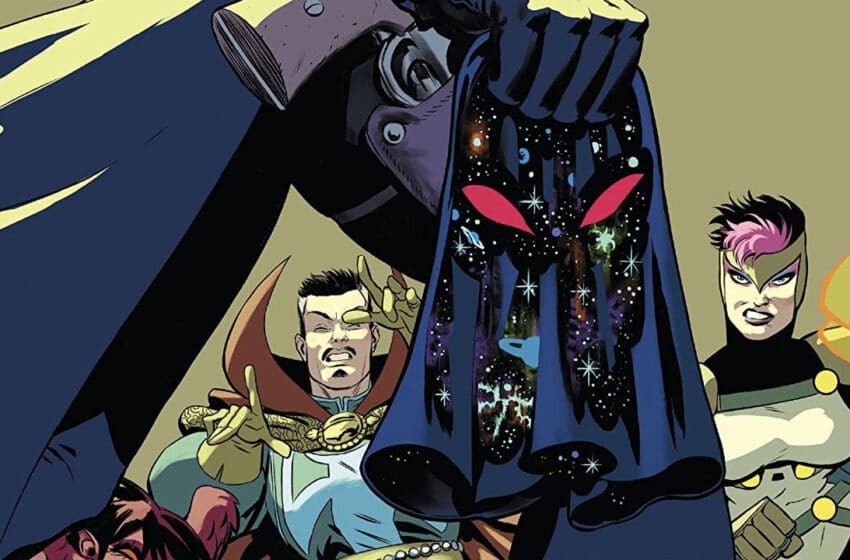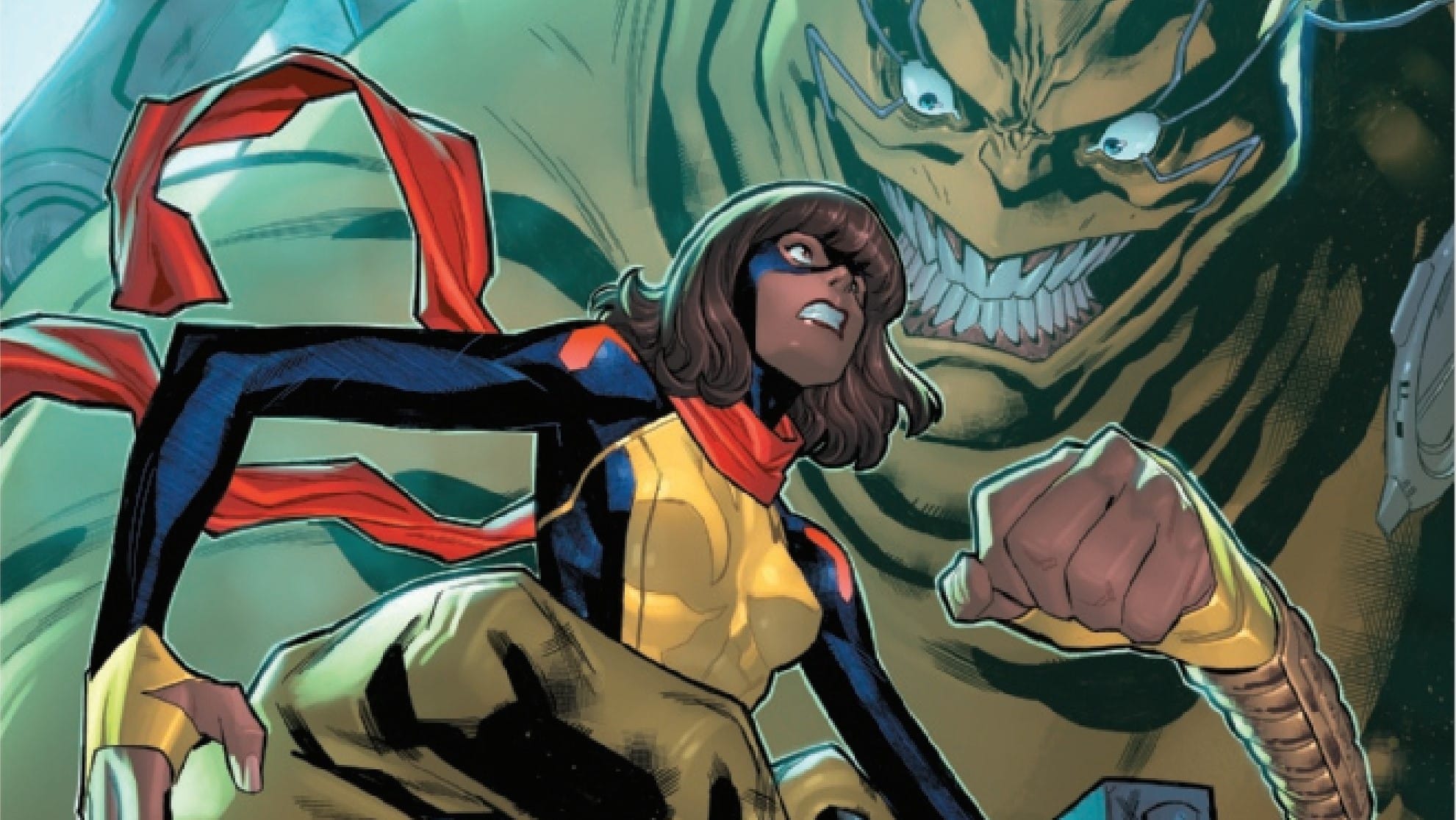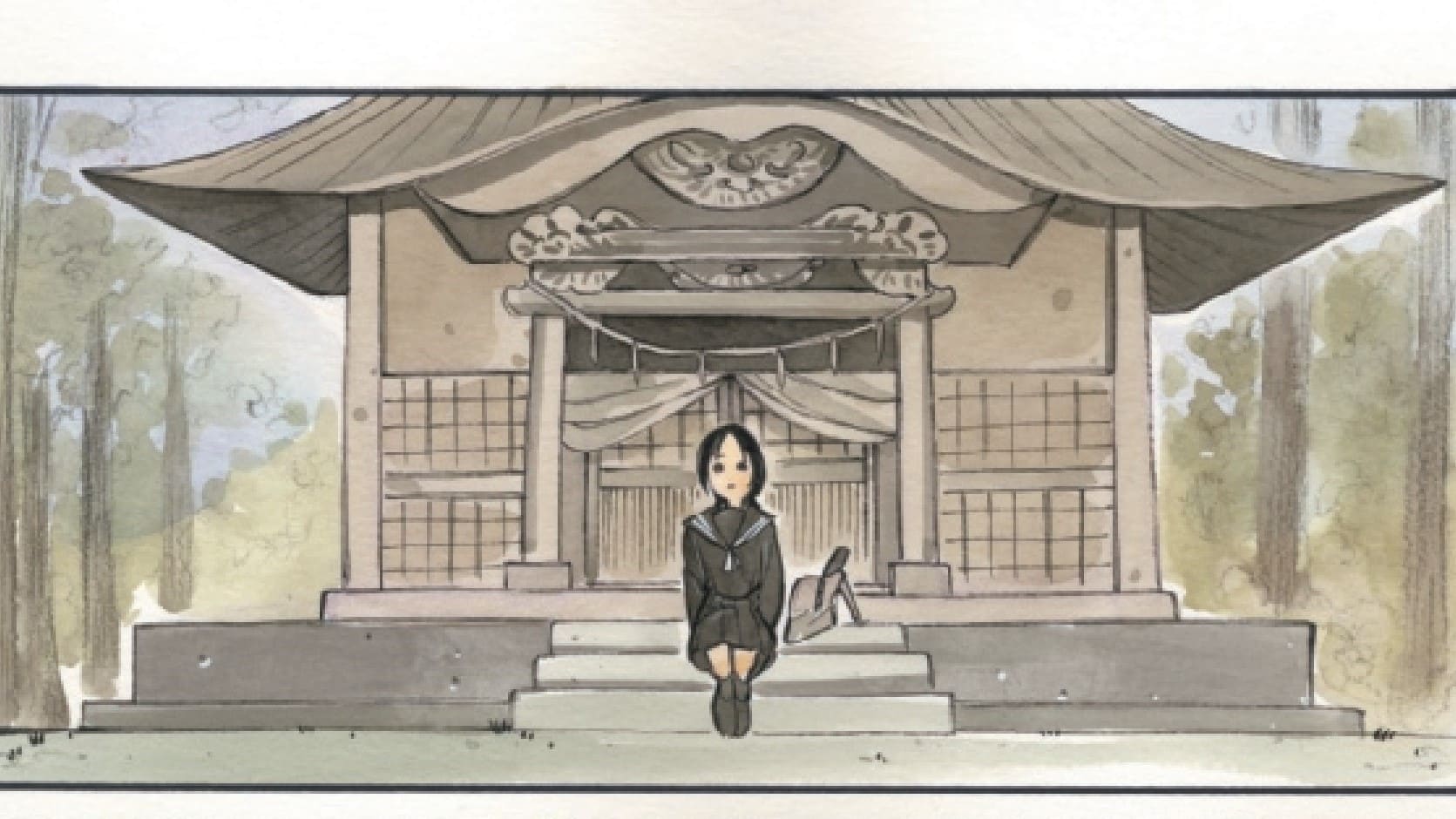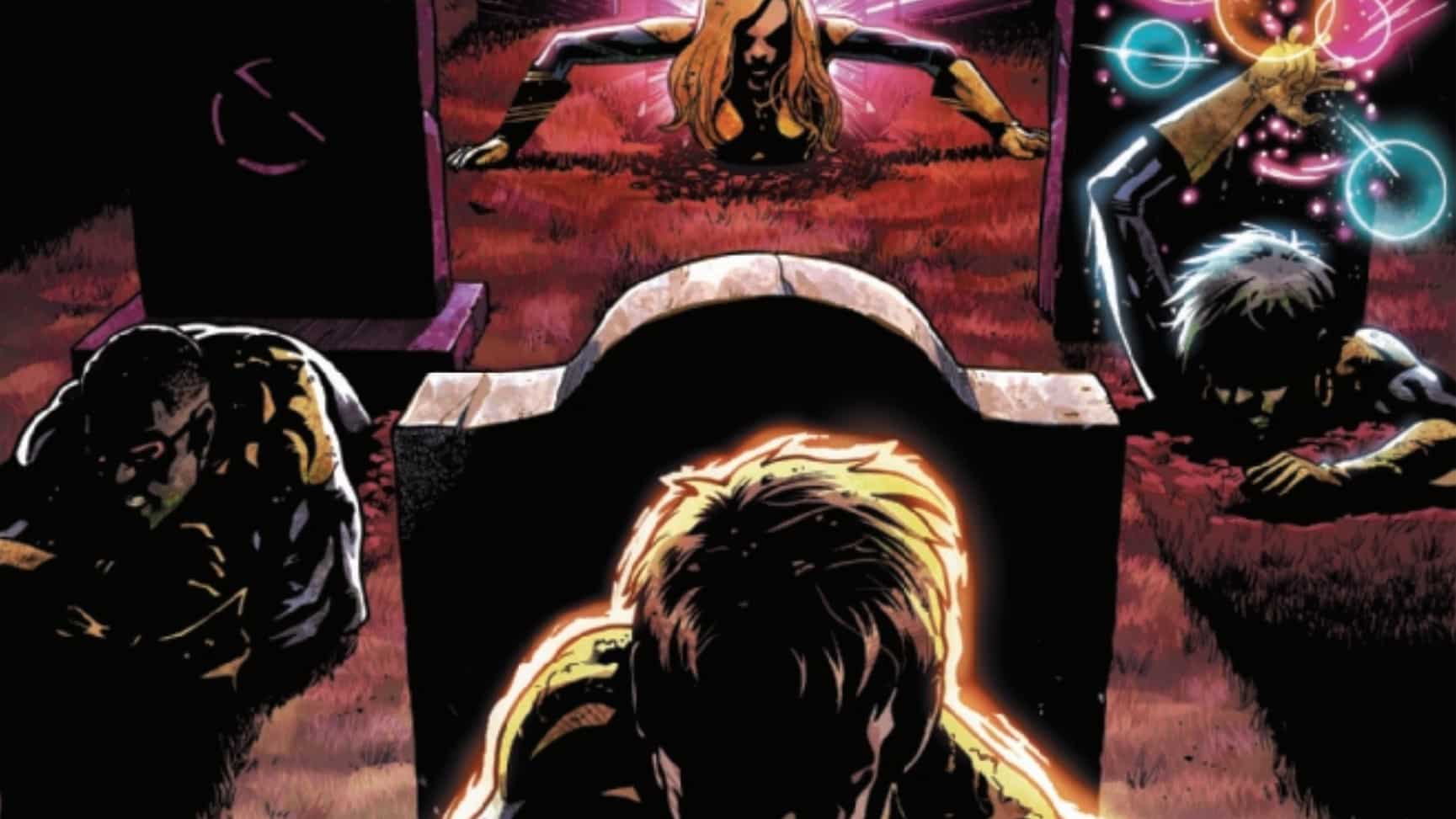The Cosmos begins, the Cosmos ends. A mask is passed on, twice. Being and unbeing battle for the very existence of existence. Welcome to the Third Cosmos. There will be surviving, there will be experience. Defenders #5 is told by Al Ewing and Javier Rodriguez, with letters by Joe Caramagna.
Mark Turetsky: Welcome back, Stephanie, for the final Defenders-style team-up in this weird, formalist expedition of Defenders #5. Where comics publishing history begets Marvel cosmogony.
Stephanie Burt: Happy to be here. I guess. This sure is…fun to look at. Mark,why are you wearing a full face mask?
Mark: Umm… It’s not important. No more questions! Let me ask you: I sense some reticence about this issue. I take it it didn’t land well for you?

Mark: I’ll grant you that it’s a comic with a lot of buy-in. In the Kieron Gillen and Al Ewing panel at Meanwhile… In Bristol, Ewing mentioned that Defenders was an ending of sorts for a lot of his work at Marvel. It’s the culmination of his work on Mighty Avengers, Ultimates, (and both series’ relaunches) a little bit of S.W.O.R.D. and most directly his stories in Marvel Comics #1000 and #1001. And the characters in this are, almost explicitly, dealt with less as characters and more as roles to be played. I called his treatment of his characters sterile back in the review for issue #2.
But I guess I’ve just accepted that this is what this mini is, with all the publishing delays and whatnot since it started way back in August of last year. And I really enjoyed this issue for what it is.
Stephanie: Good for you. I read comics for the art and for the characters, and there’s some pretty wonderful art here.
Mark: This issue is set in The Third Cosmos, which seems like a pretty small place. It seems like distance doesn’t exist, with the characters unable to tell whether the grand fight between Lifebringer One and Anti-All is right in front of them or light years away. They had already lost the sense of time last month in their trip through the Fourth Cosmos, so it makes sense that space would be next. There’s no time, there’s no space. There’s just a struggle between being and nothingness. It’s the Jean-Paul Sartre of universes. I also noticed that Lifebringer One and Anti-All don’t speak at all. They have no language because we saw that get invented in the next cosmos down the line. It’s all very abstract. So, if being and nothingness are new concepts in this cosmos, what exactly was going on in the previous two?
Stephanie: Isn’t that like asking what came before the Big Bang, or (in some Jewish traditions) asking what G-d did before G-d created the universe? We can’t know and we’re not supposed to ask.
Mark: Our steadfast editor Zach (Hi Zach, we perceive you!) likened this to the cleaving of Tehom, in Bereshit (Genesis, for your Greek-speakers). In the biblical cosmology, Tehom is a vast, undifferentiated ocean, “The deep” in the opening verses of the King James translation. So is Tehom the second cosmos? Ewing’s guide to the various cosmoses from Ultimates #100 just lists the Second Cosmos as “First of the new breed. Originator of the Omega force,” so, who the heck knows?
Stephanie: Even more than Defenders 4, this issue’s all about the iconography. It’s an allegory of types interacting, not a story about imaginary people having feelings or making choices. It’s more like one of William Blake’s epic poems than like a more traditional epic or a novel or almost any other cape comic. I’m amazed and a bit delighted that Marvel published it, even though it’s definitely not my jam (I believe it is Douglas Wolk’s jam). And as I reread it I’m seeing more and more clues for interpreters, not in the dialogue or the plot but in the visual choices that Javier Rodriguez (perhaps from Ewing’s script, perhaps not) made.
For example, Lifebringer One, the First Sentry, looks an awful lot like a 1940s comic book hero, from the dawn of comic book time, if you like. He also looks like the Art Deco Mercury from Rockefeller Center. And he’s very simply the first incarnation of the actual Marvel hero The Sentry, eternal opponent of the Void, whose unending binary struggle against nonexistence symbolizes, depending on who you ask, the endless struggle to protect humanity, the work that is never completed and never abandoned, or the zero-sum, ultimately frustrating nature of the superhero trade.
Mark: The big reveal, which has been teased since 2019, is the unmasking of The Masked Raider. It’s Zota himself. I found something appropriate in the Mask Raider dying in a battle literally against himself, considering his mask makes him equal to any opponent. But the whole thing left me scratching my head as to where and when exactly this second Zota showed up. I think I’ve worked it out, but it’s not altogether clear in the text. My theory is this: back in issue #1 of this mini, the Masked Raider talks about confronting Zota, trying to stop his plan, but failing as Zota begins to cast a time travel spell. The Masked Raider then shoots Zota’s spellbook, and this happens:

It sure looks to me like maybe multiple Zotas got sent back in time. One was sent into the previous Cosmos, another was sent to a day before Blind Justice dies, and Blind Justice passes on the Eternity Mask. At which point, that Zota assumes the mantle of The Masked Raider and tries to stop Zota from moving forward with his plan, trying to free himself, but ultimately trapped in a time loop (he says shooting the book is “the only thing I could do” and we realize now how literal he’s being with that statement).
Stephanie: OK, I’ll take it. I’ve kinda lost interest in making sense of the plot as if the characters were characters, though. I’m a lot more interested in what Ewing’s allegory says about the nature and purpose and pleasure of superhero comics as a genre, and maybe of comics as a medium, and maybe of art and human life. It’s all about the binary struggle against your opposite number, who also emanates from within you and who represents timelines you did not realize, choices you did not make: behind the mask of your ultimate opponent, you will– of course– find your own face. That’s in Blake, it’s in Yeats, it’s in various East Asian traditions I can’t begin to understand, and it’s at least preferable to the rank Freudianism of the superhero comics in which a boy has to kill Dad once and for all. It still seems a bit, well, binary. And maybe a little bit gendered.
The Masked Raider comes from a time before superheroes, from the prehistory of cape comics, which is to say from pulp Westerns– that’s why he’s got a six-shooter! And he leads up to a shootout at the OK Corral of the self. If I were Cloud I’d nope out before this point too. But it looks ah-maze-ing. Upside down heroes! Faceless heroes! Big black sawtooth blocks for jaws too big to fit the page! And then, when we see Zota’s fearful face, Rodriguez conducts a master class in the way that comics turn time into space. Or maybe it’s space into time. Look at all those overlapping frames, whose changes in size and placement direct the saccades of the eye to stutter, re-start, drag time back across itself. Zota, meanwhile, tells us directly that in the Third Cosmos an hour can last a whole life. Bravo.

Mark: Masked Raider is literally the prehistory of Marvel Comics, if we agree that the Marvel universe proper begins in 1961 with Fantastic Four #1. The Masked Raider comes from 22 years prior, from a Western story in Marvel Comics #1, along with Sub-Mariner, Ka-Zar, and the original Human Torch. Even Zota’s been retconned into being in the very first story of that comic.
Every comic Rodriguez draws is just a brilliant use of comic space. The light of the Zota’s lab coat, the dark of the Masked Raider’s outfit.
Stephanie: And then we go under the mask and see that Carlo Zota, Mr A-to-Z, the last critic of the first story, in defeating the Masked Raider, has killed…. himself. Thus returning everybody to the struggle between Nothing and Something, against the background of Cosmic Eternity. Who is, of course, an incarnation as well as an abstraction.
When I was a kid and my best friend and I played with action figures, one of the stories we ended up telling involved increasingly powerful cosmic entities. My Han Solo figure was the Invulnerable Man, but he could lose a fight to the Invincible Man, who in turn had to bow before the power of Cosmic Time Itself, but when the Spirit of Infinite Space-time showed up, Cosmic Time had to do her bidding, unless and until the battle between the Alpha Force and the Omega Force superseded the Spirit’s bidding, at which point the Universe would step in and judge the contestants, though they could be overruled by the Omniverse, and so on until we literally ran out of words that means “big,” “cosmic,” “powerful,” “impressive,” or “beyond measure.” Mark does the Ewing-verse feel a bit like that to you?
Mark: Universe Man is usually kind to smaller man, Person Man loses to Triangle Man. These are the primal stories that we tell in the superhero comics space.
Stephanie: They might be giant stories. If I keep remembering that I’m reading an allegory, not a story, and it’s about ideas and images, not about imaginary people with feelings, I can keep admiring this comic for what it is– really a nearly perfect and startlingly beautiful example of what it is– rather than getting peeved about what it is not.
I can also admire the multiple endings. Having agreed to sacrifice himself in a closed loop of time travel, Carlo Zota has enabled LIfebringer One and his sword (their sword? its sword?) to cleave the single story into a multiverse of infinite potential stories. And Dr. Strange gets to go home and “sit for a very long time,” he says, “coming down.” Which is an acid-trip reference if anything is, in tune with the general late-60s,early-70s, Jim Starlin-ish psychedelic vibe that suffuses the whole mini-series, and helps anyone who wants to enjoy it without taking the cosmic allegory ultra-seriously. (I would bet money that there are multiple Jim Starlin homages in this issue alone, and I’m not the person who can find them: Douglas probably is.)
Mark: The most obvious callback to Starlin for me is Zota facing off against himself from a different point in time. Adam Warlock’s most memorable (okay, second most memorable, since the first is clearly Thanos) nemesis is The Magus, a future version of himself who has created a religion to worship him. And Zota is tied into Adam’s story, as he’s a member of The Conclave that created him. There’s also a later Starlin story where, during the events of Infinity Gauntlet, it turns out that Thanos sent avatars of himself through time and one rescues a past Thanos from Mephisto. So, lots of paradoxical time shenanigans there.
Stephanie: Stephen Strange’s inner sanctum-slash-mancave is gonna end up on a lot of fans’ walls: I wonder if Javier Rodriguez has already sold or donated the original art.
Mark: Unfortunately for original comic art collectors, Rodriguez has been all-digital for a while now. Even his sometimes-inker, Álvaro López, has gone full-digital.
Stephanie: That super-fun full page also shows, on Strange’s bookshelves, a neato reading list: five books about modern pop, dance and indie music, including the autobiography of Factory Records co-founder Tony Wilson, line the shelf above the good Doctor’s head.
The bookshelf below his arm holds a tome just called “MAG,” which leaves me in the dark, and then two titles I absolutely recognize: Wolk’s recent account of all Marvel continuity, All of the Marvels, and Defenders (1972) no. 36, “A Garden of Earthly Demise,” part of the Steve Gerber-written run that Ewing clearly digs, though I’m not sure (having just read that issue) what that has to do with this… Maybe I just need to sit for a very long time.
Mark: Since Ewing mostly posts about music he likes and Rodriguez is himself a musician, I can’t decide whose idea the music tomes might have been.

Multiversal Closing Thoughts
- Doctor Strange’s farewell to his teammates occurs on a page where only one image (the First Sentry, seated) has color. Everything else is B&W. That’s cool.
- They’ve “spent” all of their color (that good ol’ Cyan, Magenta and Yellow) teaming up to defeat Anti-All, after which they appear desaturated.
- Apparently we’re gonna get more Defenders this summer. There’s even a final full-page image telling us as much. What do you call those? The backsplash page?
- Hopefully that next incarnation of Defenders includes Taaia, whose continued availability to adventure gets teased.
- Is it even possible to learn all of Dr. Strange continuity, in the way that one can learn the whole history of, say, Scott Summers or Ororo Munroe? Or is the human brain unable to sustain such arcane information?
- This isn’t even the first time traveling Doctor Strange team book to be drawn by Javier Rodriguez. So, it’s likely hopeless.
- Also, Stephanie, when you asked about the mask I wear… it’s because I’M YOU! FROM! THE! FUTURE!
- And in the future, you love this cosmic shit. It shall become YOUR VERY JAM.







